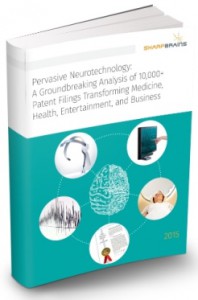Medical signal monitoring and display: Key Neurotech Patent #3
Today we are sharing a 2001 patent assigned to Carefusion 209, Inc. (As mentioned, we are featuring a foundational Pervasive Neurotech patent a day, from older to newer by issue date)
U.S. Patent No. 6,224,549: Medical signal monitoring and display
- Assignee(s): Carefusion 209, Inc.
- Inventor(s): Wirm van Drongelen
- Technology Category: EEG
- Issue Date: May 1, 2001
SharpBrains’ Take:
The ‘549 patent addresses this problem by combining EEG data with other sensor data (e.g., EMG data), together with a customizable presentation that is best suited for the nurse, doctor or patient gathering data.
Biometric data is detected for a broad range of purposes that dictate the appropriate types of data gathered, applied modalities and user interface presentation. Hence, different applications require different system that each possess a configuration specific to the biometric data application. The ‘549 patent addresses this problem by combining EEG data with other sensor data (e.g., EMG data), together with a customizable presentation that is best suited for the nurse, doctor or patient gathering data. The montage of panels in the user interface is an important aspect of the disclosure that facilitates a flexible system design. The importance of data visualization for accurate analysis and monitoring of health/medical conditions, along with the six independent claims covering various embodiments of the inventive concept, are amongst the factors making the ‘549 patent a key non-invasive neurotechnology patent.
Abstract:
The present invention provides a medical signal monitoring system and method for displaying physiological signals of different types and modalities in different formats on a single system. Physiological signals, e.g., electrical physiological signals from electrodes attached to a subject, are provided to the system. The raw wide band physiological signals may be recorded on disk, and may be processed multiple times to display desired signals of interest. The parameters used to process the signals to be displayed are selectable by an operator employing a user interface. The user interface allows an operator to define a set of panels in which one or more signals will be displayed. The type of panel selected to display the signal determines the basic format of the signal to be displayed, e.g., various types of waveforms. A signal to be displayed in a panel is defined by selecting, for example, the signals from two electrodes attached to a subject from which a montaged pair signal to be displayed is derived. The modality of the signal to be displayed, e.g., EEG, EMG, or evoked potential (EP) is operator selectable employing the user interface. The user interface also provides for operator selection of other display and analysis parameters, such as triggering, averaging, and spectral trend analysis. A signal to be displayed in a panel may be triggered from an auditory, visual, or electrical stimulation signal provided to a subject. The characteristics of the stimulation to be provided to the subject are operator selectable employing the user interface. A separate stimulus context may be established for each panel defined by an operator. Switching between different stimulus contexts is achieved via the user interface by activating a panel to which a stimulator context has been assigned.
Illustrative Claim 23. A method for displaying physiological signals of a subject, comprising the steps of:
- receiving a plurality of raw wide band physiological signals from a plurality of portions of a subject’s body;
- selecting at least one first pair of the plurality of raw wide band physiological signals;
- selecting a first modality of interest;
- combining and filtering the first pair of raw wide band physiological signals for the modality of interest to define a first physiological signal to be displayed; and
- displaying the first physiological signal to be displayed.
 To learn more about market data, trends and leading companies in the digital brain health space –digital platforms for brain/ cognitive assessment, monitoring and enhancement– check out this market report. To learn more about our analysis of 10,000+ patent filings, check out this IP & innovation neurotech report.
To learn more about market data, trends and leading companies in the digital brain health space –digital platforms for brain/ cognitive assessment, monitoring and enhancement– check out this market report. To learn more about our analysis of 10,000+ patent filings, check out this IP & innovation neurotech report.



